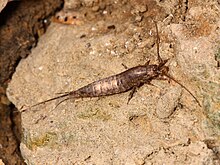古口目
| 古口目 化石时期:
| |
|---|---|

| |
| 石蛃 | |
| 科学分类 | |
| 界: | 动物界 Animalia |
| 门: | 节肢动物门 Arthropoda |
| 纲: | 昆虫纲 Insecta |
| (未分级): | 单髁类 Monocondylia Haeckel, 1866 |
| 目: | 古口目 Archaeognatha Börner, 1904 |
| 科[2] | |
| |
| 异名 | |
| |
古口目(学名:Archaeognatha)是昆虫纲无翅亚纲下的一个目,通称石蛃。古口目是现存最原始的昆虫类群,出现于泥盆纪中期,与蛛形纲起源时间相近。古生代和较近期的年代都有出土古口目的化石,其中部分物种的形态特征和一些现生的物种极为接近,这些化石包含包埋的虫体化石、虫体印痕化石,和足迹化石[3]。古口目过去又称“微首目(Microcoryphia)”。
二十世纪晚期时学者将缨尾目分为古口目与衣鱼目,这两个目都拥有类似尾巴的构造,此构造由两侧的尾毛及中间的肛上板组合而成,古口目的肛上板明显长于两侧尾毛,而衣鱼目则与两侧尾毛长度相仿[4]。古口目为单髁类,也就是所有其他非古口目昆虫(统称双髁类)的姊妹群[5]。
古口目全球广布,共分为两个科,约500个物种[6]。
描述
古口目身形修长,胸节呈拱形,体型较小。腹部末端具有尾状结构,由两侧尾毛与中央肛上板组成。触角具弹性。复眼硕大,具有三颗单眼,着生于头部顶端。口器可部分内缩,具有简易的咀嚼式大颚和较长的小颚须[1]:341–343。
古口目与衣鱼目的不同之处在于古口目的头部相对较小,且身体两侧扁平,衣鱼体型为上下扁平。古口目可以利用尾状构造跳跃,高度可达30公分。古口目还有一特点是后足基节(有些物种中足基节也有)和第二至第九腹节腹板生有带关节的附器(styli),有些学者认为这是附肢的遗迹。
其他独特特征为古口目的腹节腹板由三片骨片组成,且古口目会在蜕皮前将自己固定在物体表面上。如同衣鱼目,古口目也有易脱落的鳞片,借此躲避猎食者,也可避免外骨骼磨损。古口目的外骨骼较薄,容易脱水,偏好栖息于潮湿阴凉的环境,如树皮下或石头下。



语源学
古口目(Archaeognatha )由希腊文而来,ἀρχαῖος, (archaios) 意思为“古老的”,而γνάθος(gnathos) 意思为“颚”,该组合词意指古口目的大颚关节连接处只有单个,而其他的现生昆虫则有两个。
微首目(Microcoryphia)[4]亦来自于希腊文,μικρός(mikros) 意思为“小的”,κορυφή(koryphē) 意思为“头”[7]。
分类
| 科 | 物种数 | 区分特征 |
|---|---|---|
| 石蛃科 Machilidae | 250 | 多分布于岩岸 |
| 光角蛃科 Meinertellidae | 20 | 后足基部与腹眼不具有鳞片 |
生态学
各种栖地中都有古口目。大部分物种栖息于潮湿的土壤中,但也有栖息于灌木丛林,甚至是沙漠中的物种。大部分取食藻类,有些也会取食地衣、青苔,或其他腐败的有机质。
求偶时,雄虫会分泌精包,并将精包黏着在物体表面,接着跳起求偶舞蹈,在这之后,雌虫会捡起精包并放入产卵管中。雌虫一次大概能生下30粒卵。幼虫形态与成虫相似,约两年能达到性成熟。
与大多昆虫相异的是,古口目成虫会继续脱皮,而且每次脱皮后都会再次交配。古口目的寿命约为四年,比大多的昆虫都长寿[1]。
参考文献
- ^ 1.0 1.1 1.2 Howell V. Daly; John T. Doyen; Alexander H. Purcell. Introduction to Insect Biology and Diversity 2nd. Oxford University Press. 1998. ISBN 0-19-510033-6.
- ^ Order Archaeognatha Börner 1904. The Paleobiology Database. [26 November 2020]. (原始内容存档于2020-07-26).
- ^ Patrick R. Getty; Robert Sproule; David L. Wagner; Andrew M. Bush. Variation in wingless insect trace fossils: insights from neoichnology and the Pennsylvanian of Massachusetts. PALAIOS. 2013, 28 (4): 243–258. Bibcode:2013Palai..28..243G. S2CID 86430759. doi:10.2110/palo.2012.p12-108r.
- ^ 4.0 4.1 Timothy J. Gibb. Contemporary Insect Diagnostics: The Art and Science of Practical Entomology. Academic Press. 27 October 2014: 78– [2021-01-18]. ISBN 978-0-12-404692-4. (原始内容存档于2017-02-16).
- ^ A. Blanke, M. Koch, B. Wipfler, F. Wilde, B. Misof (2014) Head morphology of Tricholepidion gertschi indicates monophyletic Zygentoma. Frontiers in Zoology 11:16 doi:10.1186/1742-9994-11-16
- ^ The Royal Entomological Society Book of British Insects
- ^ H. G. Liddell. An Intermediate Greek-English Lexicon: Based on the 7th Ed of Liddell & Scott's Lexicon. 1889.
外部链接
- Archaeognatha(页面存档备份,存于互联网档案馆) - Tree of Life Web Project
- MicrocoryphiaVirginia Polytechnic Institute and State College Department of Entomology
| ||||||||||||||||||||||||||||||||||||||||||||||||||||||||||||||||||||||||||||||||||||||||||||||||||||||||||||||||||||||||||||||||||||||||||||||||||||||||||||||||||||||||||||||||||||||||||||||||||||||
| |||||||||||||||
Text is available under the CC BY-SA 4.0 license; additional terms may apply.
Images, videos and audio are available under their respective licenses.

